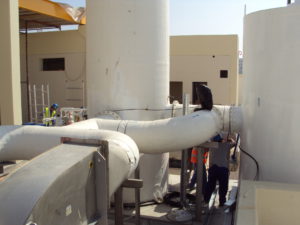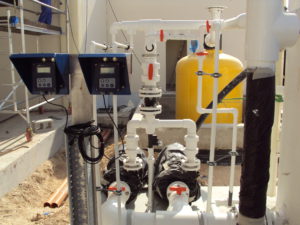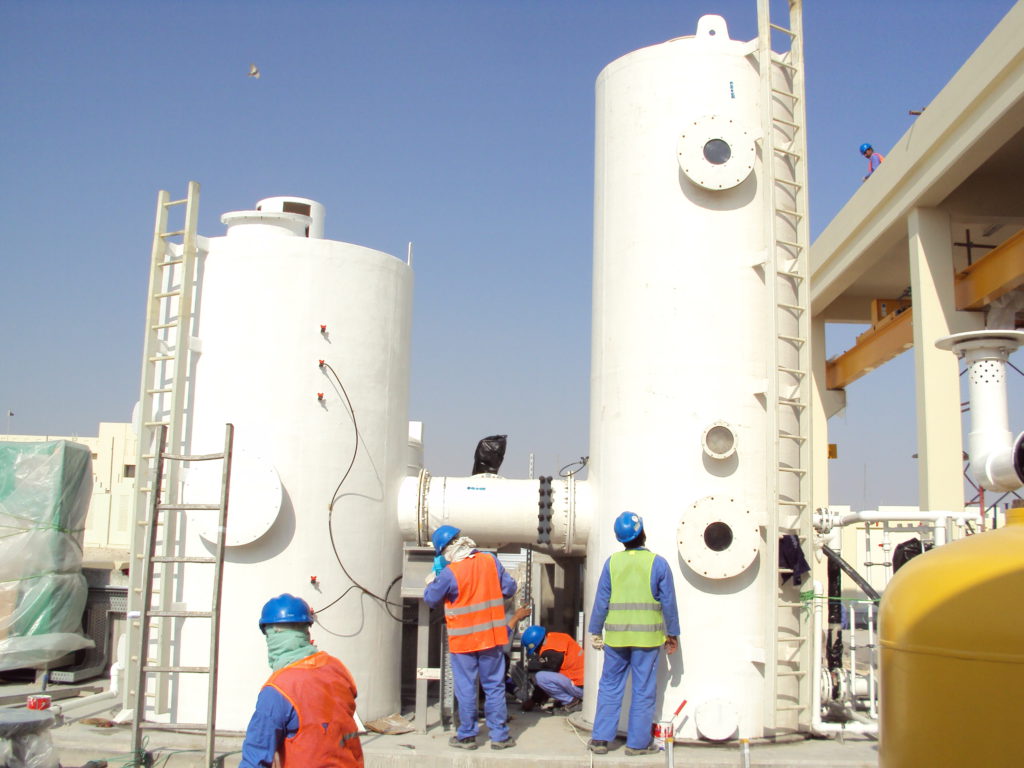Odour control unit at Ain Khalid Pumping Station – Doha Qatar
In the new development Ain Khalid, situated in the West of Doha-Qatar, a pumping station is constructed to collect the sewage of the housing within the quarter. This sewage pumping station is located in the center of a sensitive area. Because of the location, severe precautions were taken to avoid any odour nuisance from the activities of the pumping station.
The odour treatment plant for the Ain Khalid pumping station was designed, fabricated and commissioned by IPEC NV. The system exists of a dual fan system (duty-standby fans) in combination with a chemical scrubber (base – oxidizing) as first treatment, followed by an activated carbon system as a polishing step.
The fan system is able to deliver the required flow with one fan while the other fan is standby. Every week, the fans switch automatically without any interference of operating personnel. The normal flow of the system is 8630 m3/hour. When staff enters the wet well for maintenance, the speed of the fans can be increased by the frequency converter to 11500 m3/hour. By increasing the flow with 33%, the ventilation rate increases from 20 air changes to 26,6 air changes, resulting in a better indoor climate for the maintenance staff.
The first air treatment step is a scrubbing tower which is operated with an aqueous solution of caustic and bleach. The recirculation liquid is circulated over a packing material by a spraying system which is located in the upper part of the vessel. The packing material combines a low pressure drop with a high specific surface to ensure a good contact between gas phase and water phase. Dosing of the chemicals is carefully monitored by pH- and ORP-measurement to ensure an odour-free exhaust and a minimal chemical consumption. Both the recirculation pumps and the dosing pumps are provided as duty-standby. The scrubber contains a mist eliminator to prevent droplets passing to the next treatment step.
As a polishing step, a double bed activated carbon system is installed. As in most odour control units at sewage applications, Water Regenerable Activated Carbon is used. The carbon has the catalytic property to convert H2S into sulphuric acid. The sulphuric acid can be washed in situ by means of the internal spraying system that is installed in the carbon vessel. In this way the carbon can be reused several times. The saturation of the activated carbon and the subsequent regeneration process is controlled by the PLC of the unit. The regeneration is completely automated, so no manual intervention is required.
The sewage flow in the pumping station is very variable. This results in a large variation of the incoming H2S concentrations. To avoid overdosing of chemicals in the scrubber because of these fluctuations, the PLC controls the dosing of chemicals using the pH and ORP measurement and the measurement of the H2S concentration in the incoming air. Furthermore, when the H2S concentration in the air inlet is very low, the scrubber is bypassed by automated dampers and the air flows directly into the activated carbon vessel. This reduces the chemical consumption even more without affecting the performance of the system.


